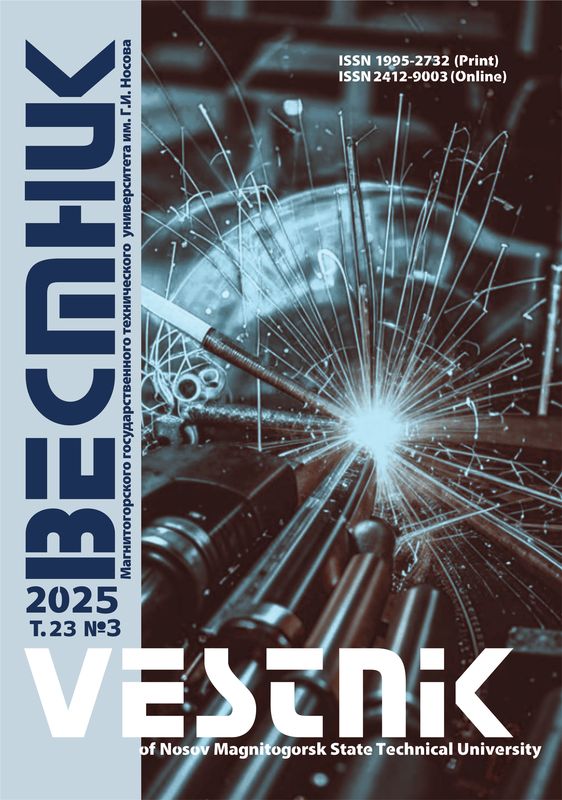Abstract
Surface alloying of AISI 420 steel was carried out in a single vacuum cycle, and consisted of spraying a thin (0.5 μm) film of Zr-Ti-Cu alloy by electric arc spraying of a cathode of the composition Zr-6 at.% Ti-6 at.% Cu, and the subsequent irradiation of the “film (Zr-Ti-Cu alloy) / (AISI 420 steel) substrate” system with an intense pulsed electron beam. It is shown that the concentration of zirconium in the surface layer of steel decreases with an increase in the energy density of the electron beam (ES). It is established that formation of a surface alloy is accompanied by the following: formation of a cellular crystallization structure (the average cell size increases from 150 nm at ES = 20 J/cm2 to 370 nm at ES = 40 J/cm2); decomposition of a solid solution with the release of zirconium carbide particles (particle sizes increase from (10-15) nm at ES = 20 J/cm2 to (30-40) nm at ES = 40 J/cm2). Particles of the carbide phase based on chromium of the composition Cr3C2, Cr7C3 and (Cr, Fe)23С6, along with zirconium carbide particles, are revealed upon the irradiation of the “film (Zr-Ti-Cu alloy) / (AISI 420 steel) substrate” system with an intense pulsed electron beam (ES = 40 J/cm2). Chromium carbide particles have a round shape; their sizes vary from 40 nm to 60 nm. The authors analyzed phase transformation diagrams taking place under equilibrium conditions in Fe-Zr-C; Cr-Zr-C; Fe-Cr-Zr systems. It is established that ultra-high cooling rates that occur during the irradiation of the “film (Zr-Ti-Cu alloy) / (AISI 420 steel) substrate” system with an intense pulsed electron beam impose limitations on the formation of phases of the intermetallic type. It is assumed that the formation of predominantly carbide phases in the surface layer of the material is due to high mobility of carbon atoms in steel.
Keywords
AISI 420 steel, electron beam processing, structure, phase composition.
1. Poate J., Foti G., Jacobson D. Surface modification and alloying: by laser, ion and electron beams. Moscow: Mashinostroeniye, 1987, 424 p. (In Russ.)
2. Andriyakhin V.M., Fishkis M.M. Lazery i perspektivy ikh primeneniya v avtomobilestroenii [Lasers and prospects of their application in the automotive industry]. Moscow: NII Avtoprom, 1980, 40 p. (In Russ.)
3. Belov A.B., Bytsenko O.A., Krainikov A.V. et al. Silnotochnye impulsnye elektronnye puchki dlya aviatsionnogo dvigatelestroeniya [High-current pulsed electron beams for aircraft engine building]. Ed. by Novikov А.S., Shulov V.A., Engelko V.I. Moscow: Dipak, 2012, 292 p. (In Russ.)
4. Bugaev S.P., Kreindel Yu.E., Shchanin P.M. Elektronnye puchki bolshogo secheniya [Electronic beams of large cross section]. Moscow: Energoatomizdat, 1984, 113 p. (In Russ.)
5. Koval N.N., Oks E.M., Protasov Yu.S., Semashko N.N. Emissionnaya elektronika [Emission electronics]. Moscow: BMSTU Publishing House, 2009, 596 p. (In Russ.)
6. Goebel D.M., Schumacher R.W. Long pulse plasma cathode e-gun. Ed. by R.M. Watkins. Proc. SPIE, 2001, pp. 1093–1098.
7. Remnev G.E., Isakov I.F., Opekunov M.S. et al. High intensity pulsed ion beam sources and their industrial applications. Surface and Coatings Technology, 1999, vol.114, pp. 206–212.
8. Uglov V.V., Cherenda N.N., Anishchik V.М., Astashinsky V.M., Kvasov N.T. Modifikatsiya materialov kompressionnymi plazmennymi potokami [Modification of materials by compression plasma flows]. Minsk: BSU, 2013, 248 p. (In Russ.)
9. Tyurin Yu.N., Zhadkevich M.L. Plazmennye uprochnyayushchie tekhnologii [Plasma strengthening technologies]. Kiev: Naukova Dumka, 2008, 216 p. (In Russ.)
10. Gribkov V.A., Grigoriev F.I., Kalin B.A. et al. Perspektivnye radiatsionno-puchkovye tekhnologii obrabotki metallov [Prospective radiation-beam technologies for metal processing]. Moscow: Krugliy stol, 2001, 528 p. (In Russ.)
11. Kadyrzhanov K.K., Komarov F.F., Pogrebnyak A.D. et al. Ionno-luchevaya i ionno-plazmennaya modifikatsiya materialov [Ion-beam and ion-plasma modification of materials]. Moscow: MSU Publishing House, 2005, 640 p. (In Russ.)
12. Barvinok V.A., Bogdanovich V.I. Fizicheskie osnovy i matematicheskoe modelirovanie protsessov vakuumnogo ionno-plazmennogo napyleniya [Physical basis and mathematical modeling of the processes of vacuum ion-plasma spraying]. Moscow: Mashinostroeniye, 1999, 309 p. (In Russ.)
13. Andreev A.A., Sablev L.P., Shulaev V.M., Grigoriev S.N. Vakuumno-dugovye ustroystva i pokrytiya [Vacuum-arc devices and coatings]. Kharkov: NSC KIPT, 2005, 236 p. (In Russ.)
14. Sorokin V.G., Volosnikova A.V., Vyatkin S.A. et al. Marochnik staley i splavov [Grade guide of steels and alloys]. Ed. by Sorokin V.G. Moscow: Mashinostroeniye, 1989, 640 p. (In Russ.)
15. Ivanov Yu.F., Krysina O.V., Petrikova E.A., Teresov A.D., Shugurov V.V., Tolkachev O.S. Complex electron−ion plasma treatment of titanium: methods, structure, properties. J. High Temp. Mater. Proc. 21(1) (2017), pp. 53–64.
16. Halleck H. Dvoynye i troynye karbidnye i nitridnye sistemy perekhodnykh metallov [Double and triple carbide and nitride systems of transition metals]. Moscow: Metallurgiya, 1988, 319 p. (In Russ.)
17. M. Jiang, K. Oikawa, T. Ikeshoji, L. Wulff, K. Ishida. J. Phase Eq. 4 (2001) 406–17.
18. Lakishev N.P. Diagrammy sostoyaniya dvoynykh metallicheskikh system [State diagrams of binary metal systems]. Moscow: Mashinostroenie, 1996–2000, vol. 1–3. (In Russ.)
19. Malakhova T.O., J. Alloys At. Energ. (1979) 123–130.












